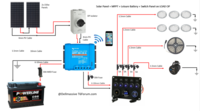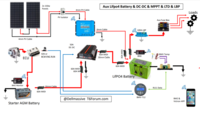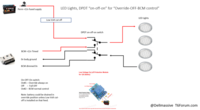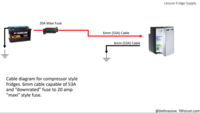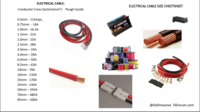A quick one to be sure. If we are taking a wire from leisure battery to two cbe fuse boards (so that is two lots of the four spade fuses) what thickness cable would you suggest? 10mm?? Seems pretty chunky.
running off the fuses are led lights and also 3 x 12v sockets. One will have a fridge plugged in (dometic cool box type)
it depends on what power you plan on drawing . . .
you say 3 x 12v sockets . . . . but if you plugged a 12v tyre pump in you could draw 10amps or more, so the diagram shows the thicker wires to account for that.
if your referring to this diag . . .

if your just using low amp stuff you could use thinner cable . . . have a look at these:
***********
Kit List And Stuff -- How I Done It & What I Use --
***********
rough ratings are:
- High temperature thin wall low voltage cables suitable for use in the automotive, marine and allied industries - Comes as a 10m loose coil
- Manufactured in accordance with ISO6722-1:2011 (Class B) 105°C
- Suitable for 12v and 24v systems (Maximum voltage 60v)
- Conductor Cross Section(mm²) - 0.5mm - 11Amps, 0.75mm - 14Amps. 1.0mm - 16.5Amps, 1.5mm - 21Amps, 2.0mm - 25Amps, 2.5mm - 28Amps
- Plain Copper Conductors to BS EN 60228:2005 - PVC Insulated
**************
so maybe look at the 2.5mm(28amp)
https://amzn.to/36i7WD3 for short runs,
increase the cable size for longer runs.
************
Twin cable (Flat 2 Core 1.5mm² 21Amps, 5 Metres) 5Metre -
https://amzn.to/35V5nY4
Twin cable (Flat 2 Core 2.0mm² 25Amps, 5 Metres) -
https://amzn.to/393hDYp
Twin cable (Flat 2 Core 3.0mm² 33Amps, 5 Metres) -
https://amzn.to/377qV41
Round Twin 2 Core Cable 12v 24v Thin Wall Wire (25 AMP Rated 2mm²) 10 Metre -
https://amzn.to/393hGU5
Single cable 1.5mm² - Car Electrical Wire, Set of 2 Colours (Red/Black) at 5m -
https://amzn.to/2MnDhx4
Single cable 2.5mm² - Car Electrical Wire, Set of 2 Colours (Red/Black) at 5m -
https://amzn.to/2MnhDIZ
6 Way Blade Fuse Box with LED Indicator for Car Boat Van -
https://amzn.to/2sSFCcr
12 Way Blade Fuse Box/Bus Bar With Cover -
https://amzn.to/2MmWtec
5 Gang Toggle Switch Panel, Dual USB Socket Charger 12V Power Outlet LED Voltmeter -
https://amzn.to/35MsHqV
.



